Middle East and Africa Diabetes Treatment Market Size
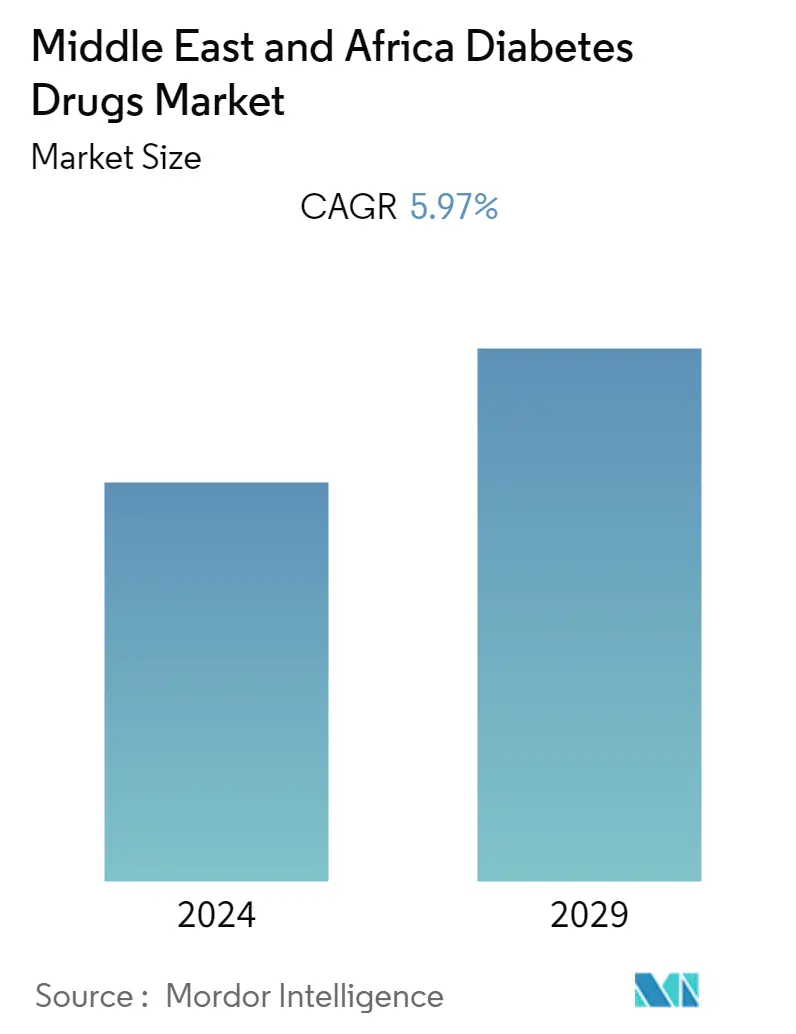
| Study Period | 2018 - 2029 |
| Base Year For Estimation | 2023 |
| Forecast Data Period | 2024 - 2029 |
| Historical Data Period | 2018 - 2022 |
| CAGR | 5.97 % |
Major Players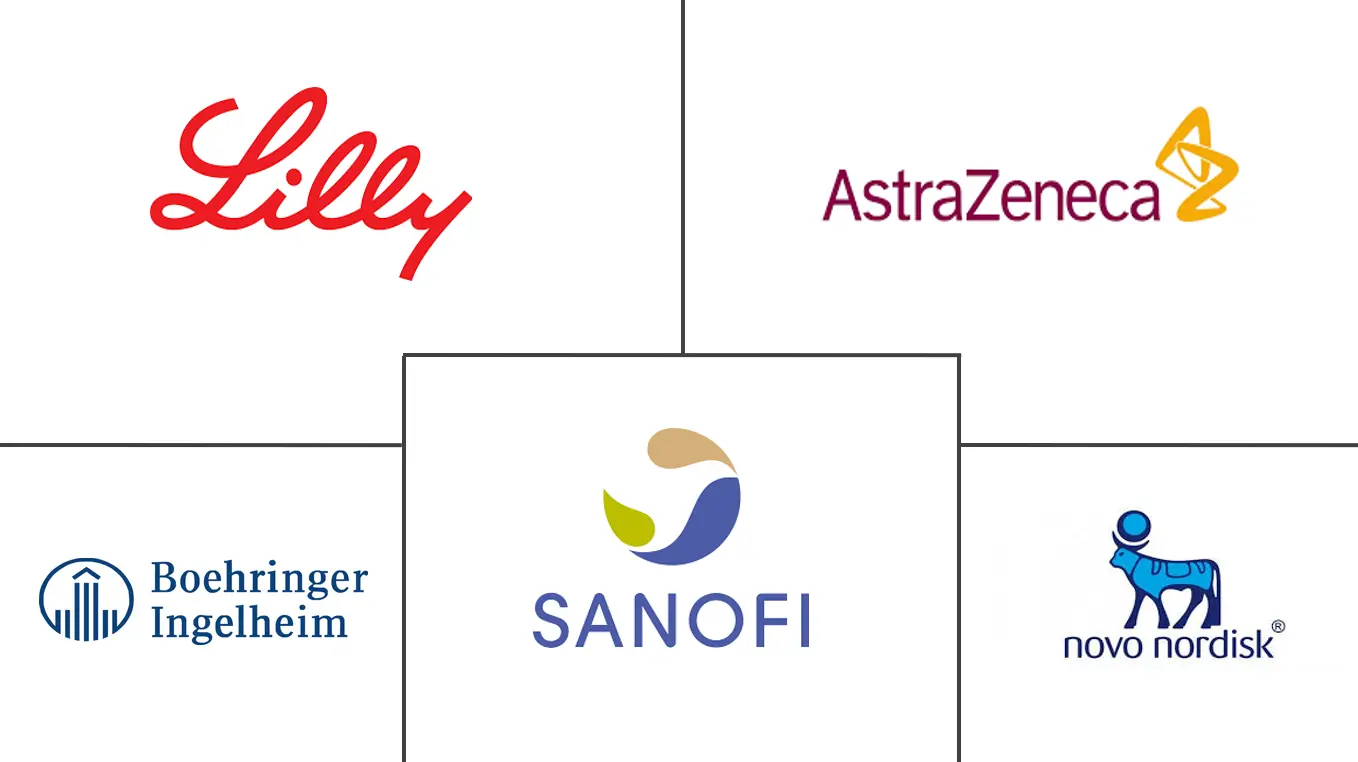
*Disclaimer: Major Players sorted in no particular order |
Middle East and Africa Diabetes Treatment Market Analysis
The Middle East and Africa Diabetes Drugs Market size is estimated at USD 4.57 billion in 2023 and is expected to reach USD 6.10 billion by 2028, growing at a CAGR of 5.97% during the forecast period (2023-2028).
The COVID-19 pandemic positively impacted the Middle East and African diabetes drugs market. Diabetes and uncontrolled hyperglycemia are risk factors for poor outcomes in patients with COVID-19, including an increased risk of severe illness or death. People with diabetes have a weaker immune system, the COVID-19 complication aggravates the condition, and the immune system gets weaker very fast. People with diabetes have more chances of getting into serious complications than normal people.
Diabetic drugs are medicines developed to stabilize and control blood glucose levels among people with diabetes. Diabetic drugs are commonly used to manage diabetes. Diabetic drugs have been potential candidates for treating diabetic patients affected by SARS-CoV-2 infection during the COVID-19 pandemic. Seventy-three million adults (20-79) were living with diabetes in the IDF MENA Region in 2021. This figure is estimated to increase to 95 million by 2030. Forty-eight million adults in the IDF MENA Region live with impaired glucose tolerance, increasing their risk of developing type 2 diabetes. Diabetes was responsible for 796,000 deaths in the IDF MENA Region in 2021. USD 33 billion was spent on healthcare for people with diabetes in 2021.
The Middle East and African regions witnessed an alarming increase in the prevalence of diabetes in recent years. The rate of diabetes is at an all-time high, mainly due to lifestyle changes. Diabetes is associated with many health complications. Patients with diabetes require many daily corrections to maintain nominal blood glucose levels, such as administering additional insulin or ingesting additional carbohydrates by monitoring their blood glucose levels.
Therefore, owing to the factors mentioned above, the studied market is anticipated to witness growth over the analysis period.
Middle East and Africa Diabetes Treatment Market Trends
The Oral Anti-Diabetic Drugs Segment is expected to dominate the Middle East and Africa Diabetes Drugs Market over the forecast period
The oral anti-diabetic drugs segment is expected to dominate the Middle East and Africa diabetes drugs market and register the highest CAGR of about 7.7% over the forecast period.
Oral anti-diabetic drugs have been available internationally and are recommended for use when escalation of treatment for type-2 diabetes is required along with lifestyle management. Oral agents are typically the first medications used in the treatment of type-2 diabetes due to their wide range of efficacy, safety, and mechanisms of action. Antidiabetic drugs help diabetes patients keep their condition under control and lower the risk of diabetes complications. People with diabetes may need to take antidiabetic drugs for their whole lives to control their blood glucose levels and avoid hypoglycemia and hyperglycemia. Oral anti-diabetic agents present the advantages of easier management and lower cost, so they became an attractive alternative to insulin with better acceptance, which enhances adherence to the treatment.
In July 2022, Zydus Lifesciences announced that it received final approval to market empagliflozin and metformin hydrochloride tablets in multiple strengths. Empagliflozin and metformin hydrochloride tablets are used with proper diet and exercise to improve glycemic control in adults with type-2 diabetes mellitus. They are also used to lower the risk of cardiovascular death in patients with type-2 diabetes mellitus and established cardiovascular disease.
Governments in the ME have identified the threat of diabetes and started to respond with various policies, initiatives, and programs. Most countries have fully implemented national diabetes treatment guidelines. Six out of 15 countries in this region still do not have a national operational action policy for diabetes. Many countries still do not have a national strategy to reduce overweight, obesity, and physical inactivity, which are important risk factors for diabetes. However, constant measures are being taken to minimize diabetic complications.
Owing to the rising rate of obesity, the growing genetic factors for type-2 diabetes, the increasing prevalence, and the aforementioned factors, it is likely that the market will continue to grow.
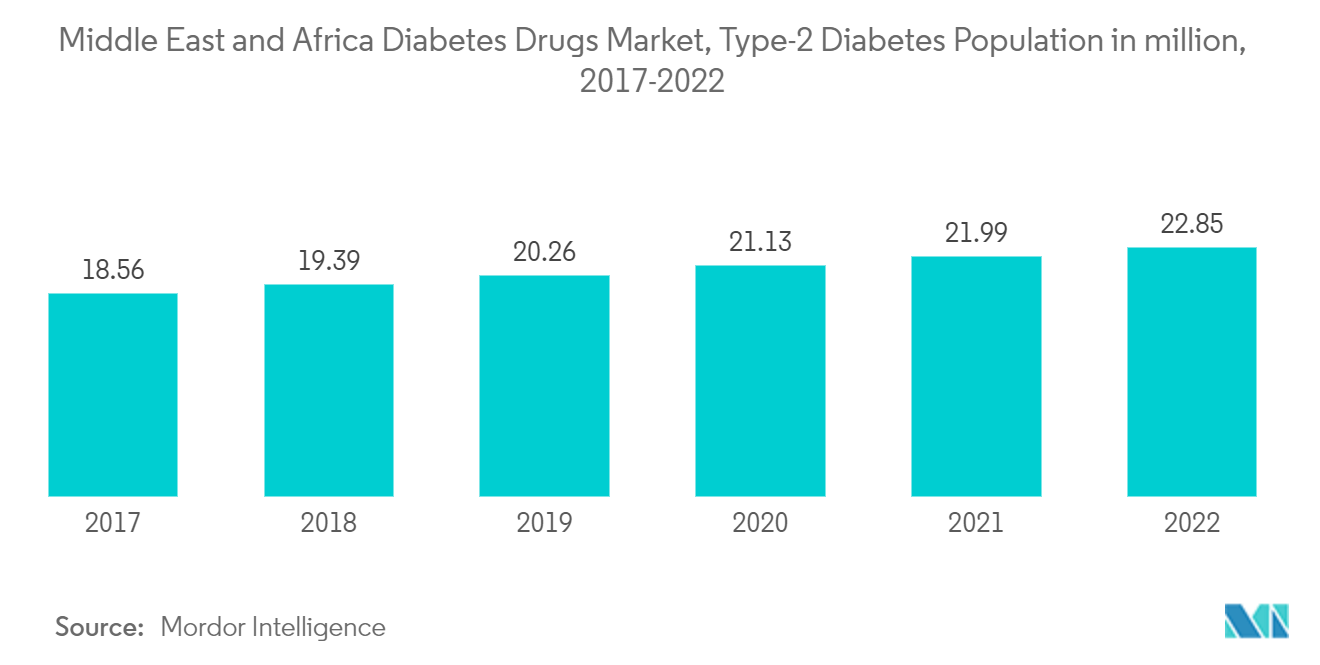
Saudi Arabia is expected to dominate the Middle East and African Diabetes Drugs Market over the forecast period
Saudi Arabia holds the highest market share in the Middle East and African diabetes drug markets and is also expected to register a CAGR of around 12.1% over the forecast period.
More than one in ten people in Saudi Arabia lived with diabetes, and the prevalence of the disease was expected to almost double by 2045, according to the IDF 2021 report. The IDF report mentioned that 4.27 million people in Saudi Arabia, which has a population of about 34.8 million, have diabetes, while 1.86 million people have the disease but are yet to be diagnosed. This figure is estimated to increase to 5.6 million by 2030 and further to 7.5 million by 2045.
The growing incidence, prevalence, and progressive nature of the disease have encouraged the development of new drugs to provide additional treatment options for diabetic patients. Non-insulin treatments, used as first-line therapies for patients suffering from type-2 diabetes, currently capture more than half the sales in the anti-diabetic market. Over the past decade, two important classes have entered this market: dipeptidyl peptidase-4 inhibitors (DPP-4) and sodium-glucose cotransporter-2 inhibitors (SGLT-2). Oral antidiabetic agents work in various ways to reduce blood sugar levels in people with type-2 diabetes; some stimulate insulin secretion by the pancreas, and others improve the responsiveness of cells to insulin or prevent glucose production by the liver. Others slow the absorption of glucose after meals.
There have been constant innovations and studies relating to drug molecules or formulation technologies. For instance, Hanmi Pharmaceutical announced in September 2021 that its new, long-acting diabetes biologic drug, efpeglenatide (GLP-1 RA), was shown to significantly reduce incidences of major adverse cardiovascular events (MACE) and kidney disease in the results of its global, large-scale clinical trial with more than 4,000 patients, adding to the efficacy of the drug.
In July 2022, the Saudi Government announced that Saudi Arabia saw growing demand for quality healthcare services, spurred by changes including an increasing and aging population and a growing prevalence of lifestyle diseases such as diabetes and obesity. The government and private sector are both involved in working on healthcare entities, certifications, and regulations. The government is taking steps to have 100 percent of Saudi citizens covered by insurance and is working towards ensuring affordability, access, and quality digital healthcare and primary care with cost-effectiveness.
Owing to the aforementioned factors, the market is expected to grow during the forecast period.
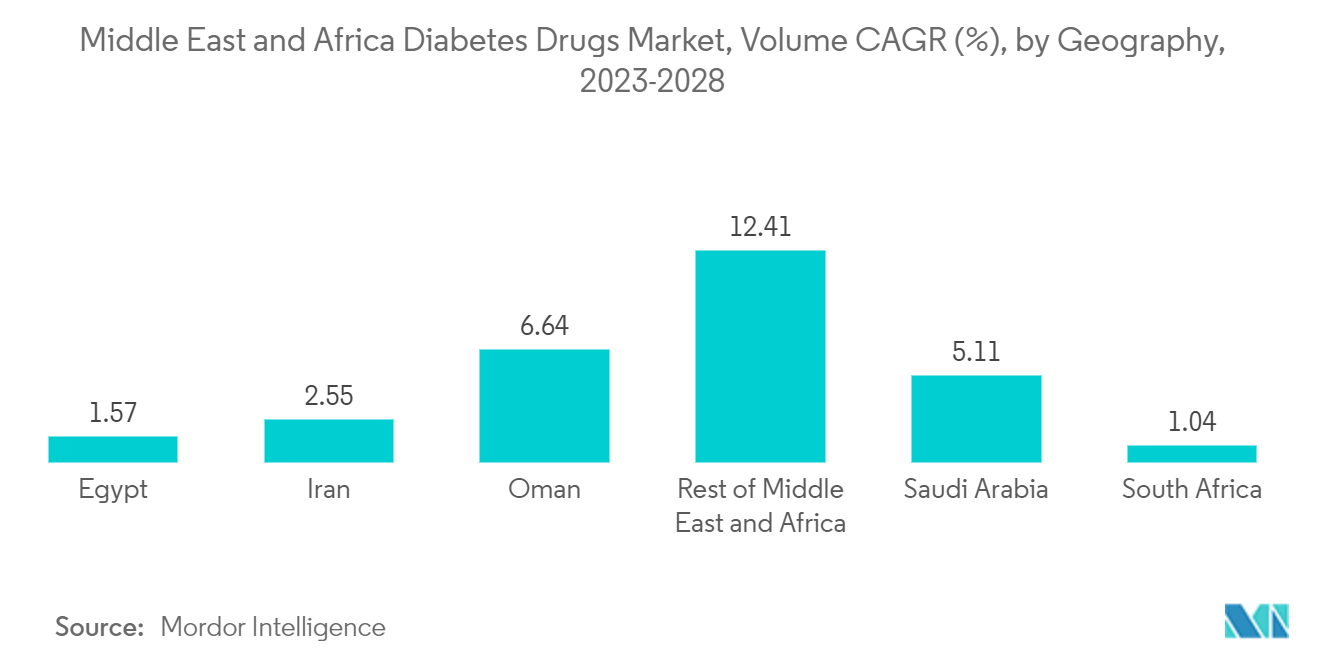
Middle East and Africa Diabetes Treatment Industry Overview
The Middle East and African diabetes drugs market is moderately fragmented, with major manufacturers, namely Eli Lilly, Sanofi, Novo Nordisk, AstraZeneca, etc., holding a presence in the region and other regional players. A major share of the market is held by manufacturers, concomitant with strategy-based M&A operations, and constantly entering the market to generate new revenue streams and boost existing ones. These measures taken by the market players are expected to ensure a competitive marketplace, therefore forcing the companies to experiment with more new technologies.
Middle East and Africa Diabetes Treatment Market Leaders
-
Boehringer Ingelheim
-
Astrazeneca
-
Eli Lilly
-
Sanofi
-
Novo Nordisk
*Disclaimer: Major Players sorted in no particular order
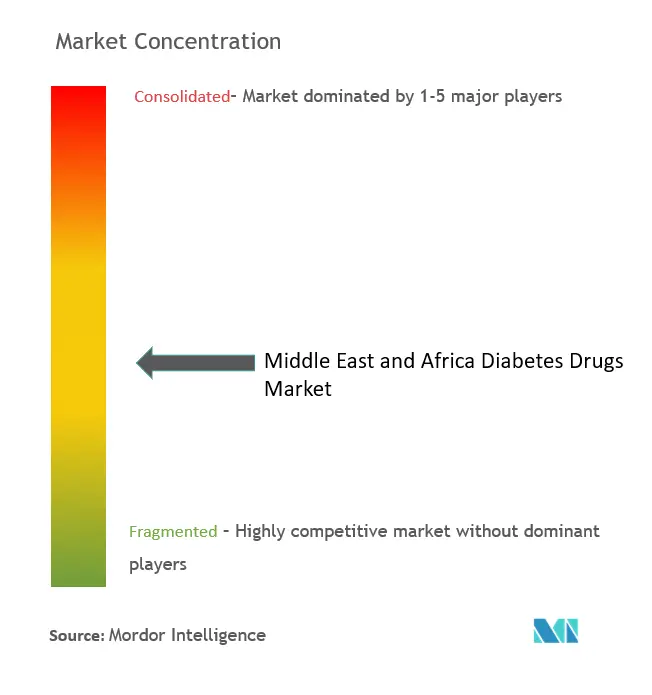
Middle East and Africa Diabetes Treatment Market News
- July 2022: Novo Nordisk launched the first-ever oral GLP-1 RA medicine to control blood glucose for type-2 diabetes patients. The Saudi Food and Drug Authority certified it, and it is now in use throughout the Kingdom and the Arab world. The company mentioned, "The treatment of GLP-1 RA has been on the market a long time ago in injection form, but our team created this innovative pill to help patients with diabetes have a normal lifestyle."
- June 2022: Gulf Pharmaceutical Industries (Julphar) and Hangzhou Zhongmei Huadong Pharmaceutical Co. announced strategic cooperation to develop, manufacture, and commercialize Liraglutide (including both indications of diabetes and obesity) in 17 countries in the Middle East and North Africa region (MENA), including the UAE.
Middle East and Africa Diabetes Treatment Market Report - Table of Contents
1. INTRODUCTION
1.1 Study Assumptions and Market Definition
1.2 Scope of the Study
2. RESEARCH METHODOLOGY
3. EXECUTIVE SUMMARY
4. MARKET DYNAMICS
4.1 Market Overview
4.2 Market Drivers
4.3 Market Restraints
4.4 Porter's Five Forces Analysis
4.4.1 Bargaining Power of Suppliers
4.4.2 Bargaining Power of Consumers
4.4.3 Threat of New Entrants
4.4.4 Threat of Substitute Products and Services
4.4.5 Intensity of Competitive Rivalry
5. MARKET SEGMENTATION
5.1 Oral Anti-diabetic Drugs
5.1.1 Biguanides
5.1.1.1 Metformin
5.1.2 Alpha - Glucosidase Inhibitors
5.1.2.1 Alpha - Glucosidase Inhibitors
5.1.3 Dopamine -D2 Receptor Agonist
5.1.3.1 Bromocriptin (Cycloset)
5.1.4 Sodium-glucose Cotransport -2 (SGLT-2) Inhibitor
5.1.4.1 Invokana (Canagliflozin)
5.1.4.2 Jardiance (Empagliflozin)
5.1.4.3 Farxiga/Forxiga (Dapagliflozin)
5.1.4.4 Suglat (Ipragliflozin)
5.1.5 Dipeptidyl Peptidase - 4 (DPP-4) Inhibitors
5.1.5.1 Januvia (Sitagliptin)
5.1.5.2 Onglyza (Saxagliptin)
5.1.5.3 Tradjenta (Linagliptin)
5.1.5.4 Vipidia/Nesina (Alogliptin)
5.1.5.5 Galvus (Vildagliptin)
5.1.6 Sulfonylureas
5.1.6.1 Sulfonylureas
5.1.7 Meglitinides
5.1.7.1 Meglitinides
5.2 Insulins
5.2.1 Basal or Long Acting Insulins
5.2.1.1 Lantus (Insulin Glargine)
5.2.1.2 Levemir (Insulin Detemir)
5.2.1.3 Toujeo (Insulin Glargine)
5.2.1.4 Tresiba (Insulin Degludec)
5.2.1.5 Basaglar (Insulin Glargine)
5.2.2 Bolus or Fast Acting Insulins
5.2.2.1 NovoRapid/Novolog (Insulin Aspart)
5.2.2.2 Humalog (Insulin Lispro)
5.2.2.3 Apidra (Insulin Glulisine)
5.2.3 Traditional Human Insulins
5.2.3.1 Novolin/Actrapid/Insulatard
5.2.3.2 Humulin
5.2.3.3 Insuman
5.2.4 Biosimilar Insulins
5.2.4.1 Insulin Glargine Biosimilars
5.2.4.2 Human Insulin Biosimilars
5.3 Combination drugs
5.3.1 Insulin combinations
5.3.1.1 NovoMix (Biphasic Insulin Aspart)
5.3.1.2 Ryzodeg (Insulin Degludec and Insulin Aspart)
5.3.1.3 Xultophy (Insulin Degludec and Liraglutide)
5.3.2 Oral Combinations
5.3.2.1 Janumet (Sitagliptin and Metformin)
5.4 Non-Insulin Injectable drugs
5.4.1 GLP-1 receptor agonists
5.4.1.1 Victoza (Liraglutide)
5.4.1.2 Byetta (Exenatide)
5.4.1.3 Bydureon (Exenatide)
5.4.1.4 Trulicity (Dulaglutide)
5.4.1.5 Lyxumia (Lixisenatide)
5.4.2 Amylin Analogue
5.4.2.1 Symlin (Pramlintide)
5.5 Geography
5.5.1 Saudi Arabia
5.5.2 Iran
5.5.3 Egypt
5.5.4 Oman
5.5.5 South Africa
5.5.6 Rest of Middle East and Africa
6. MARKET INDICATORS
6.1 Type-1 Diabetic Population
6.2 Type-2 Diabetic Population
7. COMPETITIVE LANDSCAPE
7.1 COMPANY PROFILES
7.1.1 Novo Nordisk AS
7.1.2 Takeda
7.1.3 Pfizer
7.1.4 Eli Lilly
7.1.5 Janssen Pharmaceuticals
7.1.6 Astellas
7.1.7 Boehringer Ingelheim
7.1.8 Merck and Co.
7.1.9 AstraZeneca
7.1.10 Bristol Myers Squibb
7.1.11 Novartis
7.1.12 Sanofi Aventis
- *List Not Exhaustive
7.2 COMPANY SHARE ANALYSIS
7.2.1 Novo Nordisk AS
7.2.2 Sanofi Aventis
7.2.3 Eli Lilly
7.2.4 AstraZeneca
7.2.5 Janssen Pharmaceuticals
7.2.6 Merck and Co.
7.2.7 Others
8. MARKET OPPORTUNITIES AND FUTURE TRENDS
Middle East and Africa Diabetes Treatment Industry Segmentation
Diabetes Drugs are used to manage diabetes mellitus by lowering the glucose level in the blood. The Middle East and Africa Diabetes Drugs Market is segmented into drugs (Insulin, Oral anti-diabetic drugs, Non-Insulin Injectable drugs, and Combination Drugs) and Geography (Saudi Arabia, Iran, Egypt, Oman, South Africa, and the rest of the Middle East and Africa). The report offers the value (in USD) and volume (in Units) for the above segments. Further, the report will cover a segment-wise breakdown (Value and Volume) for all the countries covered under the Table of Contents.
| Oral Anti-diabetic Drugs | |||||||
| |||||||
| |||||||
| |||||||
| |||||||
| |||||||
| |||||||
|
| Insulins | |||||||
| |||||||
| |||||||
| |||||||
|
| Combination drugs | |||||
| |||||
|
| Non-Insulin Injectable drugs | |||||||
| |||||||
|
| Geography | |
| Saudi Arabia | |
| Iran | |
| Egypt | |
| Oman | |
| South Africa | |
| Rest of Middle East and Africa |
Middle East and Africa Diabetes Treatment Market Research FAQs
What is the current MEA Diabetes Drugs Market size?
The MEA Diabetes Drugs Market is projected to register a CAGR of 5.97% during the forecast period (2024-2029)
Who are the key players in MEA Diabetes Drugs Market?
Boehringer Ingelheim, Astrazeneca, Eli Lilly, Sanofi and Novo Nordisk are the major companies operating in the MEA Diabetes Drugs Market.
What years does this MEA Diabetes Drugs Market cover?
The report covers the MEA Diabetes Drugs Market historical market size for years: 2018, 2019, 2020, 2021, 2022 and 2023. The report also forecasts the MEA Diabetes Drugs Market size for years: 2024, 2025, 2026, 2027, 2028 and 2029.
Middle East and Africa Diabetes Drugs Treatment Industry Report
Statistics for the 2024 Middle East and Africa Diabetes Drugs Treatment market share, size and revenue growth rate, created by Mordor Intelligence™ Industry Reports. Middle East and Africa Diabetes Drugs Treatment analysis includes a market forecast outlook to 2029 and historical overview. Get a sample of this industry analysis as a free report PDF download.



